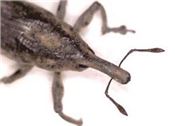The Ragweed Weevil, A Harmless Visitor Of Soybean Fields In Kentucky
DR. RAUL VILLANUEVA
PRINCETON, KENTUCKY
During the last past 5 years, I have found a brownish weevil in soybean research plots at the University of Kentucky’s Research and Education Center at Princeton and in commercial soybean fields. These encounters occurred while I was scouting for insect pests.
This insect is known as the ragweed weevil Lixus scrobicollis (Coleoptera: Curculionidae) (Figure 1).
This species is found in most areas of North America and is associated with giant ragweed, Ambrosia trifida, a noxious weed that is the main host of this insect. Ragweed weevils live and feed on this plant and make tunnels into the stems. It lays eggs on stalks and may overwinter in the tunnels in the stems. There is not much information on this insect.
It has a brownish to dark brown coloration, 1.5 cm-long (0.6 in) from the tip of the rostrum to the end of abdomen. It has an elbowed antennae and robust rostrum (snout) (Figure 2).
The findings of this weevil has been sporadic (3 to 5 specimens/year).
I might have noticed this weevil because the entomology research plots are adjacent to weed science fields. In the weed science site, studies with giant ragweed had been conducted during past growing seasons.
The ragweed weevil was reported as pest of beets. However, it does not represent a major concern in soybeans, and its feeding was not reported anywhere else. ∆
DR. RAUL VILLANUEVA: Entomology Extension Specialist, University of Kentucky

Figure 1. Ragweed weevil Lixus scrobicollis
Photos: Raul T. Villanueva, UK

Figure 2. Rostrum and elbowed and capitate antenna of the ragweed weevil